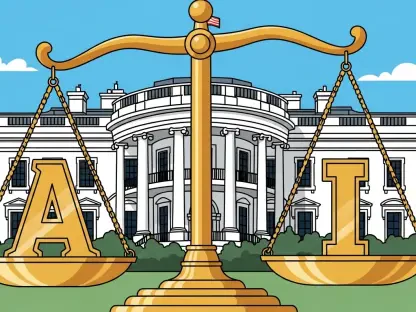Imagine a classroom where artificial intelligence tailors lessons to each student’s unique learning style, automates grading for overworked teachers, and predicts academic challenges before they arise, transforming the educational experience. This vision of AI-driven education is already becoming a reality in many schools across the United States. However, with this technological leap comes a pressing concern: the lack of robust regulation to ensure that AI tools protect student privacy, maintain educational integrity, and avoid ethical pitfalls. As AI continues to reshape learning environments, the urgent need for oversight has sparked debates among educators, policymakers, and industry leaders.
The Promise and Perils of AI in Education
Artificial intelligence holds immense potential to revolutionize education by personalizing learning experiences through adaptive platforms that cater to individual student needs. Tools powered by AI can analyze vast amounts of data to identify gaps in understanding, recommend resources, and even assist with administrative tasks like scheduling or record-keeping. This capability promises to free up educators to focus on mentoring and inspiring rather than being bogged down by paperwork.
Yet, beneath this promise lie significant risks that cannot be ignored. Privacy breaches from AI chatbots or learning apps could expose sensitive student information, while security vulnerabilities in these systems might invite malicious exploitation. Beyond technical concerns, there is a deeper worry about how over-reliance on AI might dull critical thinking skills, as students could lean too heavily on automated answers instead of grappling with complex problems themselves.
The ethical dimension adds another layer of complexity to AI’s integration into schools. The potential for misuse, such as the creation of deepfake content to deceive or harass, poses a real threat to the trust and safety of educational spaces. Without clear guidelines, the unchecked use of AI risks undermining the very values that education seeks to instill, making regulation not just desirable but essential.
Current Regulatory Gaps and Emerging Responses
At the federal level, comprehensive legislation to govern AI in education remains elusive, hampered by political gridlock and logistical challenges in crafting policies that keep pace with rapid technological advancements. This void has left schools vulnerable, as there are no uniform standards to ensure data protection or ethical usage of AI tools. The absence of national oversight has created a patchwork of practices, with varying levels of preparedness across districts.
In response to this federal inaction, state governments have begun stepping into the breach, developing localized policies to address immediate concerns. Teachers’ unions, such as the American Federation of Teachers (AFT), have been vocal in pushing for state-level action, rejecting delays in protective measures that could leave students and educators at risk. This shift toward state-driven regulation reflects a pragmatic recognition that localized solutions can be implemented more swiftly than waiting for a national consensus.
Additionally, there is a growing trend of collaboration between educational stakeholders and industry players. Partnerships with companies like OpenAI, Microsoft, and Anthropic aim to establish baseline standards, such as data privacy agreements, to safeguard sensitive information. Initiatives like the National Academy for AI Instruction are also emerging to provide educators with guidelines and training, ensuring that AI integration is both safe and effective in classroom settings.
Challenges in Crafting Effective Regulation
One of the most significant hurdles in regulating AI in education is the lack of adequate federal funding to support implementation. Despite executive orders promoting AI adoption at the K-12 level, cuts to essential programs like nutrition and basic education funding have left schools ill-equipped to handle the technological transition. This financial shortfall creates a disconnect between ambitious policy goals and the practical realities faced by educators on the ground.
Another challenge lies in the exclusion of teachers from the national planning process for AI integration. Without input from those who directly interact with students and technology, policies risk being out of touch with classroom needs. This top-down approach often overlooks the nuanced challenges of implementing AI tools in diverse educational contexts, leading to frustration among educators who lack the resources or training to adapt.
Efforts to address these gaps are underway, with advocacy for greater teacher involvement in policy discussions gaining traction. State-level funding initiatives are also being proposed to bridge resource shortages, ensuring that schools can adopt AI responsibly. However, balancing innovation with oversight remains a delicate task, as overly rigid regulations could stifle the potential benefits of AI while insufficient rules might expose vulnerabilities.
Future Directions for AI Oversight in Schools
Looking ahead, state-driven regulations could serve as a testing ground for broader national standards, providing valuable lessons on what works in diverse educational environments. As states experiment with policies tailored to their unique needs, successful models might eventually inform a more cohesive federal framework. This bottom-up approach could accelerate the development of uniform guidelines over the next few years, from 2025 onward.
Advancements in AI technology itself will also shape the regulatory landscape, as new tools and applications emerge at a rapid pace. Policymakers will need to anticipate challenges such as increasingly sophisticated data analytics or AI-generated content, which could further complicate privacy and ethical concerns. Staying ahead of these innovations will require agility and collaboration across sectors to ensure that regulations remain relevant.
The societal impact of regulated AI in education extends beyond classrooms, influencing how future generations interact with technology. Striking a balance between fostering innovation and enforcing responsibility will be critical to ensuring that AI enhances learning without compromising core values. This dual focus will likely define the discourse on educational technology for the foreseeable future.
Reflecting on the Path Forward
Looking back on the journey of AI integration in education, it was clear that while the technology offered transformative potential, the absence of federal oversight had created significant vulnerabilities. The proactive steps taken by teachers’ unions and state governments stood out as critical responses to an urgent problem, highlighting the importance of localized action in the face of national delays. Collaborations with industry leaders had also laid a foundation for ethical standards, even as challenges persisted.
Moving forward, a key next step should involve prioritizing educator input in shaping AI policies, ensuring that those on the front lines have a voice in decisions that affect their work. Increased funding at both state and federal levels is essential to equip schools with the tools and training needed for safe AI adoption. Additionally, fostering ongoing dialogue between policymakers, technologists, and educators could help anticipate future challenges, paving the way for regulations that truly balance innovation with accountability.









